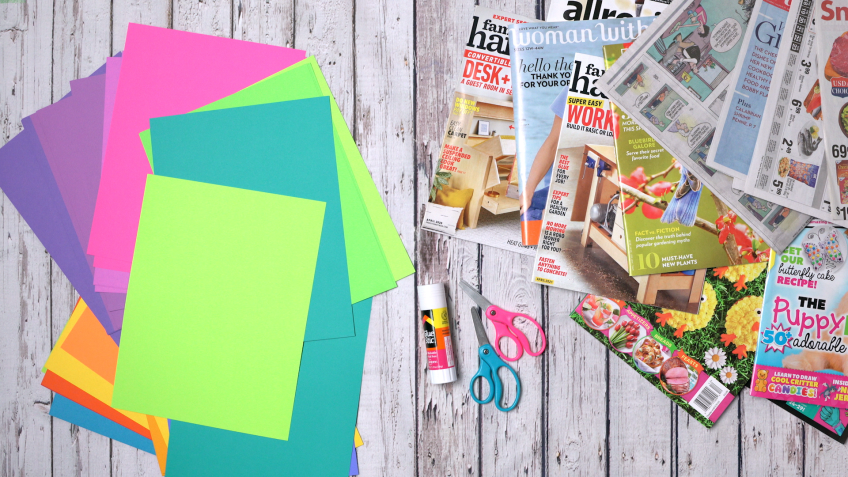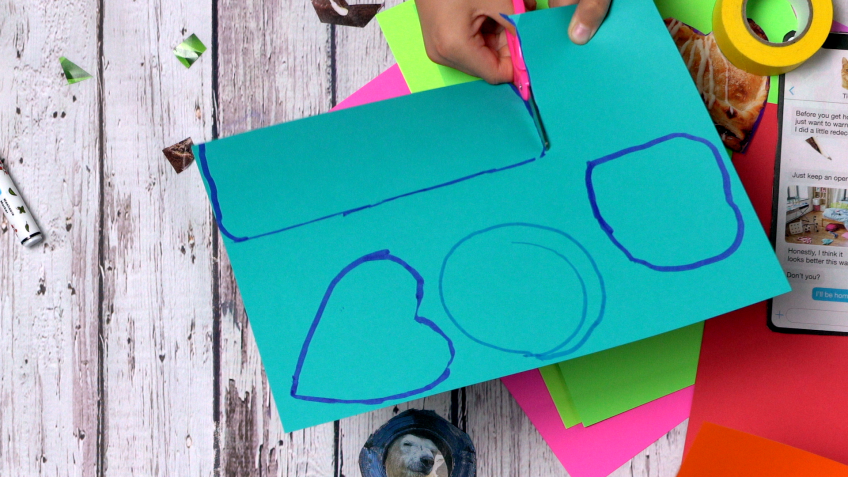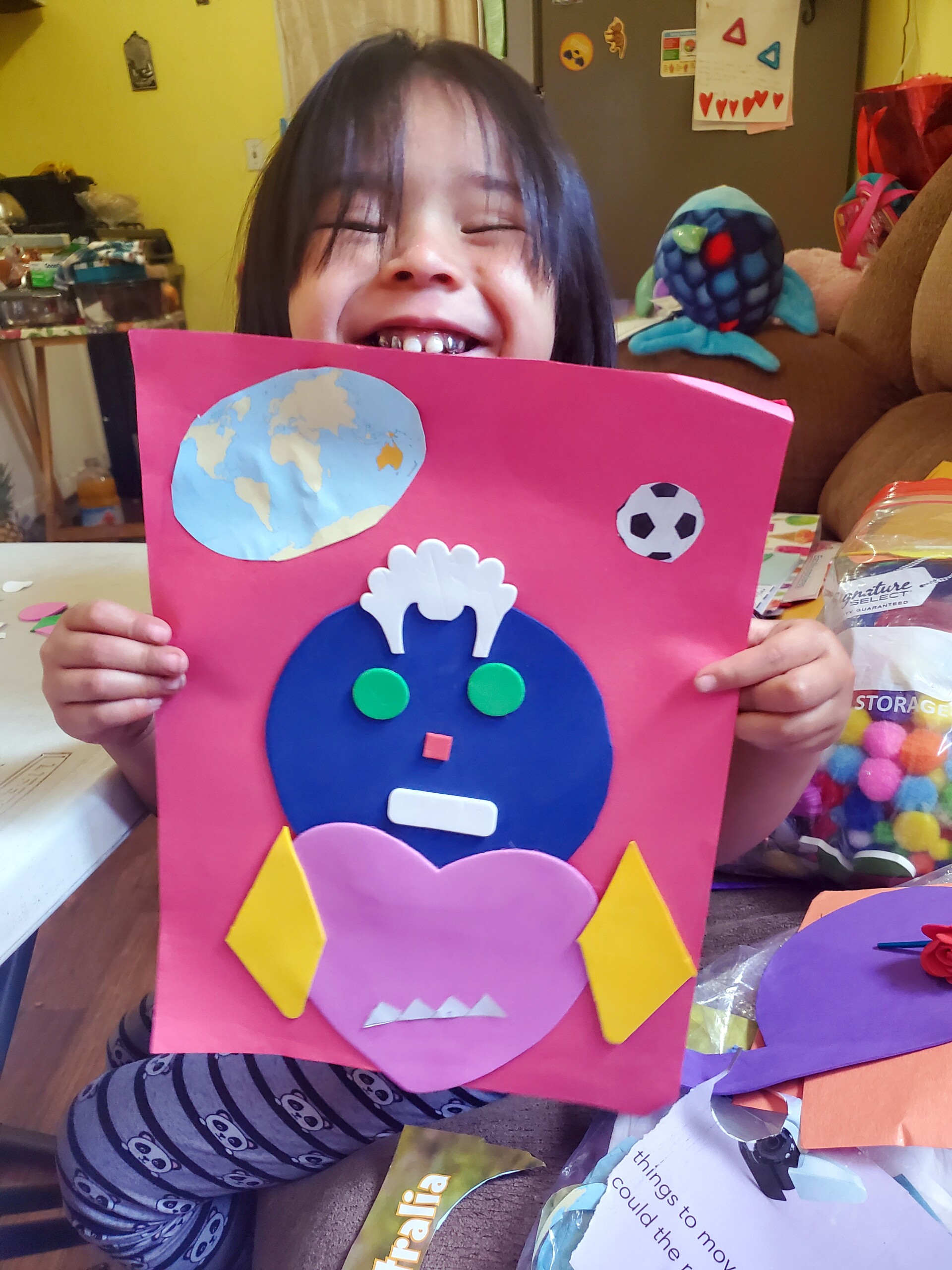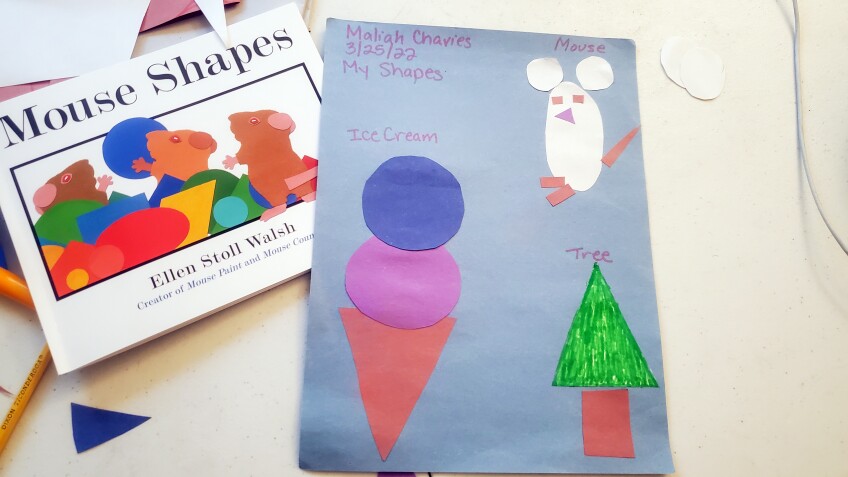Go on a Shape Hunt
This activity is an expanded version of the one seen on the video above.
Learning Goal
Shapes are everywhere! We can tell what kind of shape we are looking at by its attributes, like how many sides the shape has, if it is round or pointy or if the shape is flat or solid. In this activity you will help your child learn about shapes by going on a shape hunt together!
Materials

- Magazines, newspapers or mail to look for shapes in
- Construction paper
- Scissors
- Glue stick or tape
- Thick paper to use as a base for the image collage
- Markers, paper tape and decorations (optional)
Step-by-Step Instructions
1. Open one of the magazines, newspapers or mail and point to one of the shapes you see. Talk to your child about its attributes. You can say “This picture has four sides that are all the same length. And, the sides all connect together at the corners.”
2. Point to another shape on the page and ask your child about its attributes. “How many sides does this shape have?” “Is it round?” “Are all the sides the same length?” “Are two of the sides the same length?” “How many corners are there?”
3. Ask your child to look for similar shapes. “Can you find another picture that is round?” “What does the shape of this picture remind you of?”

4. Next, identify the names of shapes based on their attributes. Point out a picture that forms a rectangle (has four straight sides and four corners). You can say “A shape with four sides and four corners is called a rectangle. Here is a rectangle.” “Can you find a page with another rectangle? It can be a different size than my rectangle.”
Repeat this last step for other common shapes. Here are ways to identify them and language you can use with your child to talk about other shapes:
- A shape with three straight sides and three corners is a triangle
- A shape with four straight sides and four corners is a rectangle
- A square is a special rectangle where all four sides are the same length
- A shape that is perfectly round is a circle
- A shape that is rounded and looks like an egg or stretched circle is an oval
5. Now, go on a shape hunt! Flip through newspapers and magazines with your child. Use scissors to cut out the shapes you and your child find. You can also use construction paper to make your own shapes!
6. Make a shape collage. Use thick paper as a mat and a glue stick or tape to attach the shape images to it. Consider laying out the shapes first to determine where they will go, then attaching them with a glue stick or tape.
7. Talk with your child about shapes as you make your collage. You can say “Shapes can be combined and separated to make new shapes. Are you using smaller shapes to make larger ones?”
8. Be creative! Use markers, different-colored tape and other supplies to add texture and dimension to your collage.
Keep the Conversation Going
- Three-dimensional shapes: Two-dimensional shapes have measurable width and height but are flat. A three-dimensional shape has width, height and depth. Introduce one new three-dimensional shape name at a time. For example, you can start with a sphere and say “The shape of this ball is called a sphere. What do you notice about the sphere?” “Does it have edges?” “Corners?”
You might want to wait to introduce three-dimensional shapes until after your child is comfortable with two-dimensional shapes to avoid introducing too many new ideas too quickly. When you introduce three-dimensional shapes, your child may use the word “circle” to describe a sphere — this is ok! You can commend their effort and encourage their learning by showing them a circle and a sphere to compare. You can say “Spheres are similar to circles — how are they similar?” “Spheres and circles are also different. How is this circle different from a sphere?”
After introducing what a sphere is, ask your child to go on a shape hunt in your house and collect all the spheres! Repeat this with cubes, cylinders and cones. Here are examples of items around your house that match these three-dimensional shapes:
- Cube: die, blocks, Rubik’s cube
- Cylinder: shaving cream, soda can, crayon, toilet paper roll
- Sphere: ball, marble, cotton ball
- Cone: ice cream cone, party hat, piece of paper rolled into a cone shape
Book Suggestion
- “Mouse Shapes” by Ellen Stoll Walsh

In this colorful picture book, three clever mice make a variety of things out of different shapes.
Families in Action
See how local families played with shapes at a PBS SoCal virtual workshop.




















Related Workshop
This activity is part of our Shapes workshop, which helps parents and caregivers playfully build children's ability to recognize shapes.


